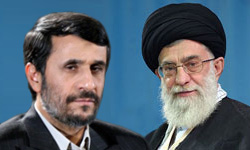Wednesday
Mar032010
Iran Interview: The State of Tehran's Nuclear Programme (Cirincione)
 Wednesday, March 3, 2010 at 0:01
Wednesday, March 3, 2010 at 0:01  Joseph Cirincione, the President of the Ploughshares Fund on nuclear weapons policy and conflict, talks to Claudio Gallo of La Stampa:
Joseph Cirincione, the President of the Ploughshares Fund on nuclear weapons policy and conflict, talks to Claudio Gallo of La Stampa:GALLO: Is Iran really trying to build a nuclear weapon?
CIRINCIONE: There is no doubt that the Iranian regime is moving to acquire the technologies that would allow it to build a nuclear weapon. We do not know if the regime has reached a decision to actually build a weapon, however.
It may make strategic sense for Iran to stop at the edge, that is, to have the uranium enrichment capability, to have secretly done design work, and to have a missile capable of carrying a warhead, but not actually build a bomb. This would give it many of the advantages of a nuclear-armed state, without provoking an attack and perhaps delaying its neighbors from reacting with their own nuclear weapon programs.
GALLO: Do you think that stress over Iran's negotiating position may point to the fact that its uranium stockpiles are ending?
CIRINCIONE: Iran does not have enough known uranium reserves to fuel its current enrichment plant at Natanz for very long. It certainly does not have enough to fuel the 10 new enrichment plants it claims it will build. But the most likely reason why the government first accepted, then rejected the uranium swap is that the regime is in crisis. It cannot get the consensus it needs to either accept or completely reject the deal.
GALLO: The Speaker of the Iranian Parliament, Ali Larijani, said recently that "based on terms of the nuclear Non-Proliferation Treaty (NPT), the International Atomic Energy Agency has no right to urge Iran to suspend its nuclear activities". Why is the West saying that Larijani is not right?
CIRINCIONE: By its own admission, Iran misled the IAEA for over 15 years. It is clearly in violation of its obligation under the NPT to report its nuclear material activities and the existence of all its nuclear material facilities. The overwhelming majority of the nations that make up the IAEA board of governors and the UN Security Council found that Iran was and still is in violation of its treaty obligation. Under the terms of the treaty, the Security Council has the right --- in fact, it has the obligation --- to ask Iran to stop its nuclear activities until Iran's good faith can be restored. Few outside of Iran dispute this basic fact.
GALLO: In the last IAEA report, they quote an Iranian study about a nuclear missile warhead. It seems that the source of that report is the same stolen laptop that since 2005 appears at intervals on western newspapers: what do you think about this?
CIRINCIONE: This is the least clear claim. The documents on the laptop do seem to be the source of this claim. It still is not clear where the laptop came from. But Iran has yet to provide any clear answers to the IAEA. Iran has just refused to answer the IAEA's questions. This raises suspicions and seems to support the claim that Iran was doing such research.
GALLO: In May 2009, you were one of the experts, American and Russian, that wrote the report "Iran Nuclear and Missile Potential": it says that Iran, if it decides, may build a nuclear warhead in six to eight years. Is that conclusion still valid?
CIRINCIONE: Since we wrote the report, the time frame for Iran building a nuclear warhead has reduced somewhat. It could probably build a small nuclear bomb in 1-2 years. It would likely take an additional few years to test the device and perfect a warhead that could fit on one of its Shahab missiles. The main reason for the decreasing time frame is Iran's production of enough low-enriched uranium that could be reprocessed into high-enriched uranium for a bomb.
GALLO: And then there is the technical difficulty to build a working IRBM [Intermediate Ballistic Range Missile]....
CIRINCIONE: Iran now has short- and medium-range missiles that can travel as far at 2000 km. It is a major challenge to build a IRBM that could fly 3000-5500 km. This is currently beyond Iran's technical capability.
GALLO: Recently on The Huffington Post, the former Deputy Director General of the IAEA, Bruno Pellaud, wrote that Iran's regime is consciously provoking an attack against nuclear facilities. Do you think it is possible?
CIRINCIONE: The regime is in turmoil. It is not clear how long it can survive. The Revolution Guard would like to change this dynamic. It is possible that the Iranian Revolution Guard is trying to provoke Israel into striking Iran. This would allow them to rally the Iranian public in defense of the nation.
GALLO: President Ahmadinejad said that Israel will attack Iran in spring or summer: do you think that Israel could attack without the American green light?
CIRINCIONE: Possibly, but very unlikely. The US military does not want to start a third war in the Middle East. JCS [Joint Chiefs of Staff] Chairman [Admiral Mike] Mullen said this week that such an attack would have "unintended consequences".
GALLO: Russia's Chief of the Army Staff, General Nikolai Makarov, warned that an American attack on Iran now, when the US is bogged down in two wars, might well lead to the collapse of the United States. Is this an old-style Russian "provokazia" [provocation] or it makes some sense?
CIRINCIONE: Not the collapse, but great turmoil, and it may unite the Muslim world against the US. Many Muslim governments would like to see the US strike Iran, but the Muslim publics would likely be enraged.




